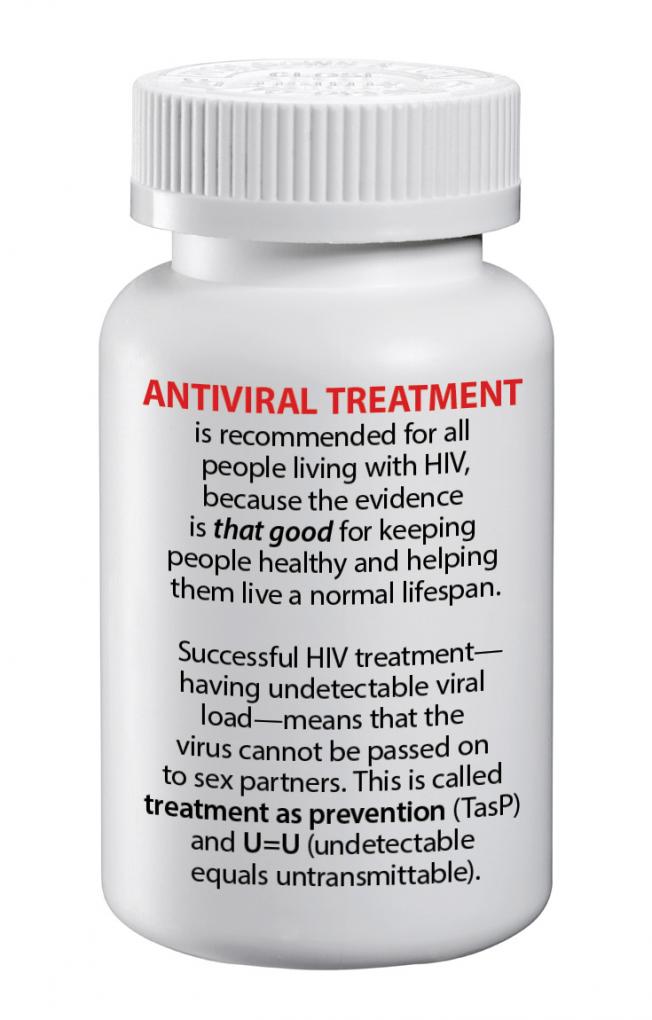
First, the good news: People can stay healthy for decades on the same HIV medicine.
My friend Joe just went off Kaletra after having been on it for about 15 years. Kaletra is a medication that’s so outdated, we no longer even include it in our annual HIV drug guide. We list it under “legacy drugs.” He had taken other HIV medications before—starting with AZT in 1987. Joe didn’t have any problems with Kaletra, but his doctor said, “we should think about a change.” After a couple of years, Joe took the plunge. He has no problem with his new regimen of Pifeltro and Tivicay, except for the cost difference. But that’s another story.
There are many people like Joe, but others aren’t so lucky when changing their drug regimen. Sometimes, for any number of reasons, an HIV regimen starts to fail. That’s when it no longer does what it’s supposed to do—most importantly, keep HIV viral load down to undetectable levels. People may then need to switch to a new drug regimen. (While not recommended, many people like to use this as an opportunity to take a break from their meds.)
Whether people are taking HIV therapy for the first time or switching to a new one, there are guidelines from the U.S. Department of Health and Human Services (DHHS) to help lead the way. There are also guidelines from the International AIDS Society-USA (IAS-USA).
Reasons for changing a drug regimen can include side effects, drug-drug interactions, and even such things as cost considerations.
The number one goal of HIV drug therapy is to get a person’s virus down to undetectable levels.
But the biggest issue here is usually drug resistance. Not a person’s resistance to taking medication—especially over a long period of time—but to the development of drug resistance in a person’s HIV.
Revenge of the mutant virus!
Here we come to a scary word: mutation. It sounds like something out of a horror film.
But all it means is change. There’s a change to a person’s HIV genome—the genetic structure of their virus. (As a living organism, HIV has its own set of genes, like we do. Weird, huh?)
HIV drugs control the virus, keeping a lid on it. But the virus resists and fights back. This can cause mutations that lead to drug resistance taking place in the virus—as a result, the medications may now no longer work as well. There are different mutations that can develop due to the different drugs. Moreover, these changes might also affect the entire drug class for that medication as well (cross-resistance). And depending on the resistance pattern or the amount of resistance found, switching regimens may be necessary and, more importantly, pose a real challenge.
This is usually called “virologic failure”—meaning that the medication’s control of the virus has started to fail. Viral load is no longer undetectable.
Looking at it another way, maybe we should say “viral success,” since HIV starts winning its struggle against the drugs. Revenge of the mutant virus! Indeed.
Undetectable
Again, the number one goal of HIV drug therapy is to get a person’s virus down to undetectable levels. “Undetectable” means too low to be picked up by a viral load test. These tests can measure down to 50, 40, or 20 viral copies per mL (milliliter) of blood, depending on the test being used.
When there are fewer than 20, 40, or 50 copies, this is called “undetectable viral load” for that particular test. Undetectable viral load, however, is considered less than 200. (There’s an older test that measures down to only 200 copies, but it’s rarely used today.)
When viral load goes to 200 or above, that’s when drug resistance testing can be called upon to see what’s going on—what mutations can be found—and can be used to help switch therapies if needed. Resistance testing is also done when someone is diagnosed with HIV, before they start any therapy at all, but those tests are looking for any transmitted resistance at that point.

Having detectable viral load is not an uncommon situation. DHHS guidelines note that, “After receiving an HIV diagnosis, about 75% of individuals are linked to care within 30 days. However, only 57% of persons who receive an HIV diagnosis are retained in HIV care. It is estimated that only approximately 55% of persons with diagnosed HIV are virally suppressed [have undetectable viral load] because of poor linkage to care and retention in care.”
The best way to prevent drug resistance is to take medication as directed—once a day, with or without food, and so forth. This is called “adherence.” (Adherence refers to other things as well, such as getting to doctor appointments.) The guidelines provide extensive information on helping people with adherence. Adherence is known to be difficult in HIV. Since the guidelines are written for medical providers, the panel of experts writing them examine this aspect of providing care.
Measuring the mutants
According to the DHHS guidelines, “The first steps for all patients with detectable viral loads are to confirm the level of HIV viremia [repeat the viral load test] and assess and address adherence and potential drug-drug interactions (including interactions with over-the-counter products and supplements) and drug-food interactions.”
People who “do not typically require a change in treatment” are those whose viral load is between that lower 20, 40, or 50 number and fewer than 200 copies: “Although there is no consensus on how to manage these patients, the risk that resistance will emerge is believed to be relatively low. Therefore, these patients should continue their current regimens and have HIV RNA [viral load] levels monitored at least every three months to assess the need for changes to ART [antiretroviral therapy] in the future.”
Resistance mutations can emerge as medications stop working against the virus.
Resistance mutations can emerge as medications stop working against the virus. The longer this goes on, the greater the chance for drug mutations to develop. Another thing that can happen is that when medications are stopped, mutations may seem to “go away” on a resistance test by hiding out, invisible to the test. This is referred to as “archived” resistance, like putting away a folder in a filing cabinet, hidden from view. Or put away in Google docs, if you prefer. This is one of the reasons why getting a treatment history is important.
For people with viral loads between 200 up to less than 1,000:
“In contrast …, those with levels that are persistently equal to or greater than 200 copies/mL develop drug resistance, particularly when HIV RNA levels are greater than 500 copies/mL. Patients who have persistent plasma HIV RNA levels in the range of 200 copies/mL to 1,000 copies/mL are considered to be experiencing virologic failure, and resistance testing should be attempted, particularly in patients with HIV RNA levels [greater than] 500 copies/mL.”
The guidelines go on this way for viral loads above 1,000.
See the box “For treatment-experienced individuals who are experiencing virologic failure” for general principles from the DHHS guidelines (next page). While this section covers general information, the guidelines continue to discuss changing drug regimens by discussing the current drugs and considerations for switching them and what to switch to. For example, “A new ARV regimen can include two fully active drugs if at least one has a high resistance barrier, such as the second-generation integrase strand transfer inhibitor (INSTI) dolutegravir (DTG) or the boosted protease inhibitor (PI) darunavir (DRV).”
There are several such statements under “Key Factors to Consider When Designing a New Antiretroviral Regimen.” Not to be confused with the heading “Antiretroviral Drug Strategies.”
Or check out “Table 11: Antiretroviral Options for Patients with Virologic Failure.” Also of special interest is “Table 5: Recommendations for Using Drug Resistance Assays.”
Help with therapy
There’s more than just talk about drugs in the guidelines. There’s a lot about helping people with their medication regimen and other challenges in life. There’s even an understanding that the term “adherence” has come to have negative connotations because of the pressure placed on people to be adherent. All of this is important whether treatment-naïve or treatment-experienced.
“Provide an accessible, trustworthy, non-judgmental multidisciplinary health care team,” say the guidelines, the very first statement in Table 19—”Strategies to Improve Linkage to Care, Retention in Care, Adherence to Appointments, and Adherence to Antiretroviral Therapy.”
And in the section’s conclusion, they reaffirm giving support to people living with HIV: “Engage a patient who is struggling with adherence at any step on the care continuum with a constructive, collaborative, nonjudgmental, and problem-solving approach rather than reprimanding them or lecturing them on the importance of adherence. … Tailor approaches to improve adherence to an individual’s needs and barriers, for example, by changing ART to simplify dosing or reduce side effects, finding resources to assist with copays or other out-of-pocket costs (see Table 19) to maintain an uninterrupted supply of ART and access to clinicians, or linking patients to counseling to overcome stigma, substance use, or depression.”
There’s more than just talk about drugs in the guidelines. There’s a lot about helping people with their medication regimen and other challenges in life.
There are so many life situations that can affect a person’s ability to take their HIV medication as prescribed and give them their best shot at avoiding drug resistance. The panel of HIV experts behind the guidelines, including community representatives, sensitively address these issues. This is probably even more important for the many providers who take care of only a few people living with HIV.
Help with adherence
Here are the suggestions from the guidelines under “Limitations to Treatment Safety and Efficacy: Key Summary of Adherence to the Continuum of Care”:
- Linkage-to-care and adherence to both antiretroviral therapy (ART) and clinic appointments should be regularly assessed.
- An individual’s barriers to adherence to ART and appointments should be assessed before initiation of ART and regularly thereafter.
- Patients with ART adherence problems should be placed on regimens with high genetic barriers to resistance, such as dolutegravir (DTG) or boosted darunavir (DRV). Side effects, out-of-pocket costs, convenience, and patient preferences also need to be considered.
- Patients having difficulties with adherence to appointments or ART should be approached in a constructive, collaborative, nonjudgmental, and problem-solving manner.
- The approach to improved adherence should be tailored to each person’s needs (or barriers to care). Approaches could include, but are not limited to:
- Changing ART to simplify dosing or reduce side effects
- Finding resources to assist with treatment costs to maintain uninterrupted access to both
- ART and appointments
- Allowing flexible appointment scheduling
- Assisting with transportation, or
- Linking patients to counseling to overcome stigma, substance use, or depression.
- Multidisciplinary approaches to find solutions to ART and appointment adherence problems are often necessary, including collaboration with social work and case management (to the extent available). The clinician’s role is to help the patient understand the importance of adherence to the continuum of care and reveal barriers to adherence, and link the patient to resources to overcome those barriers.
- A summary of best practice interventions to improve linkage, retention, and adherence can be found at a Centers for Disease Control and Prevention compendium (cdc.gov/hiv/research/interventionresearch/compendium/index.html).


